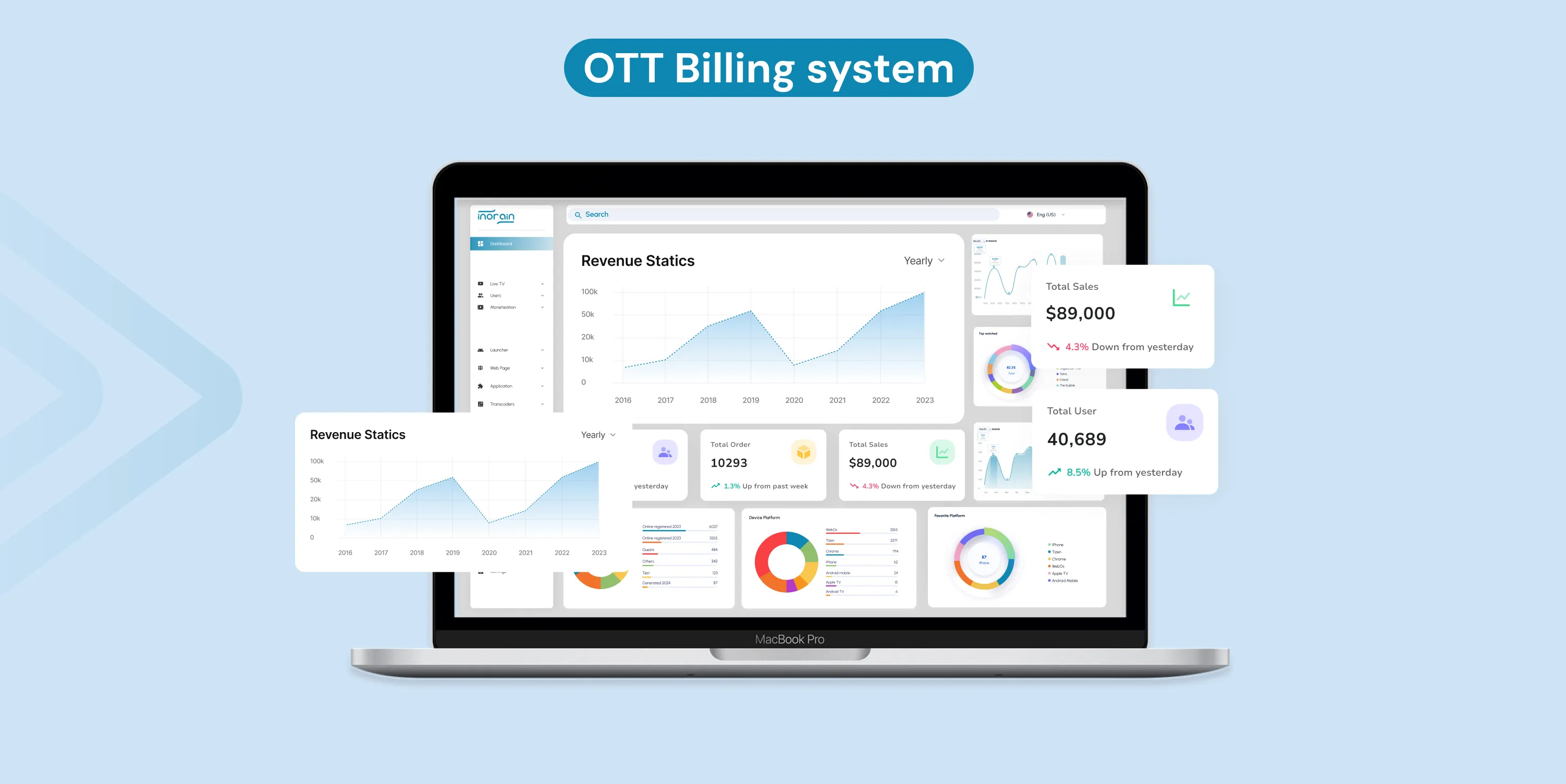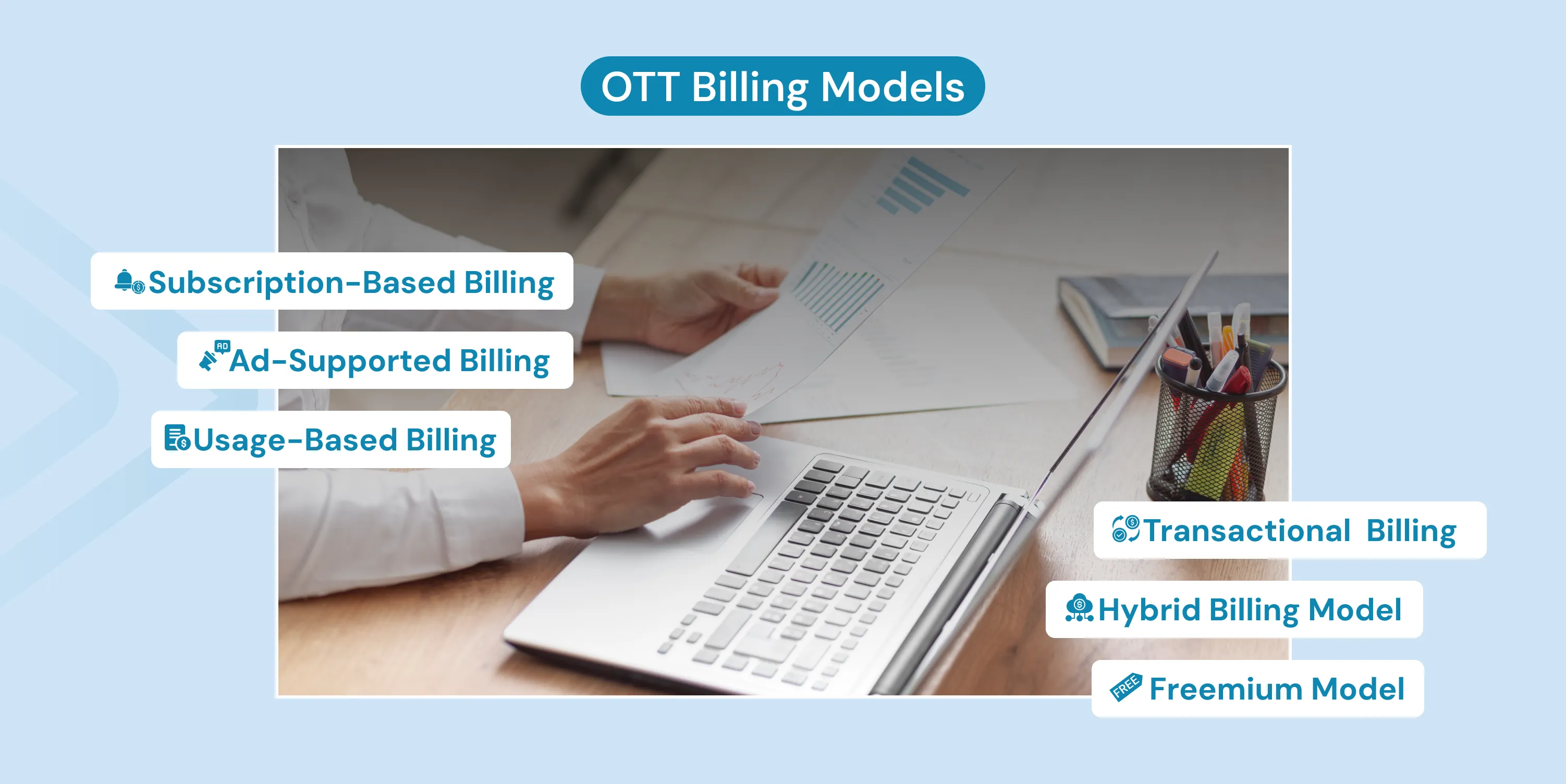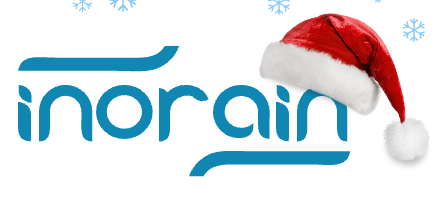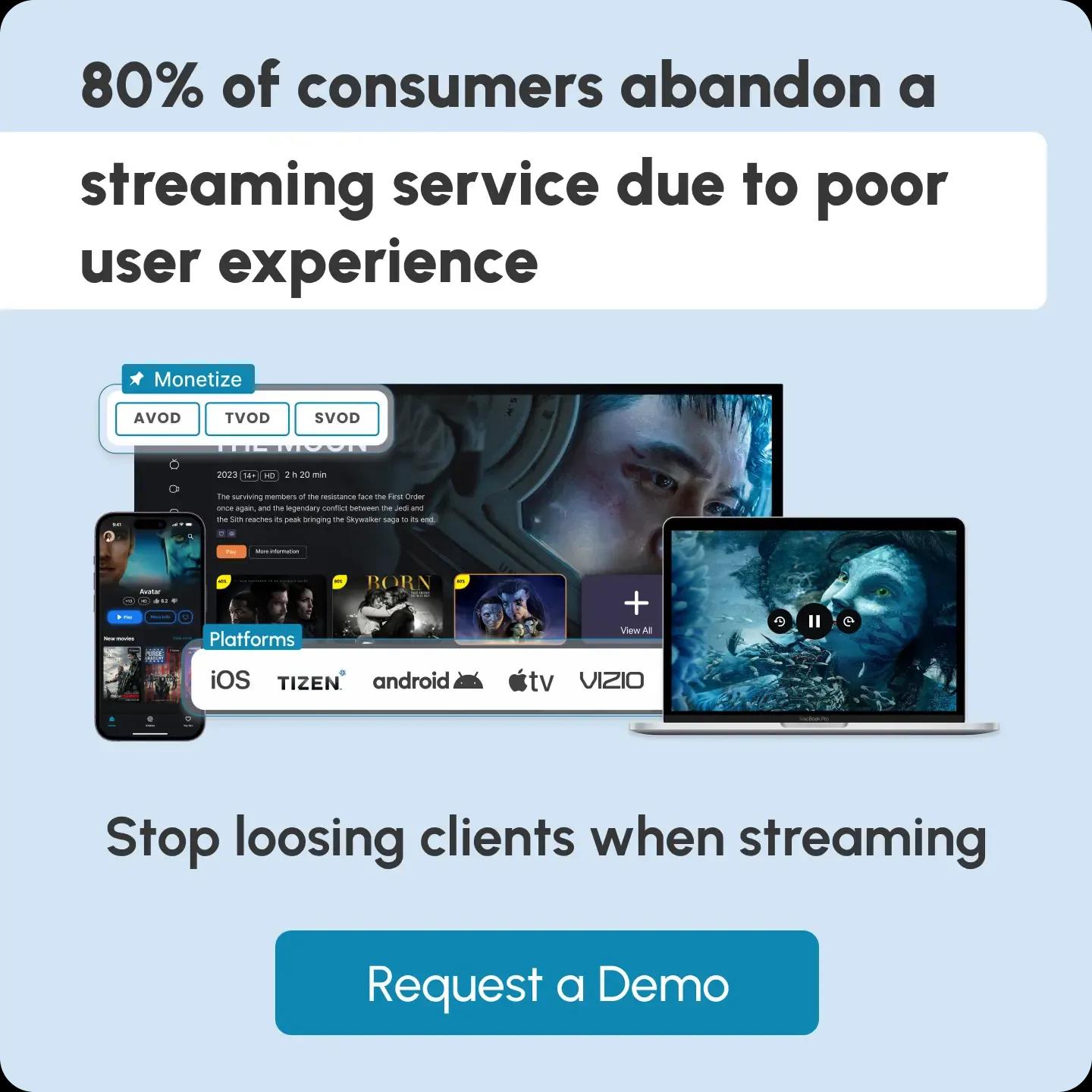
What is OTT Billing and How Does it Work?
OTT billing is essential for managing payments and subscriptions. A powerful OTT billing system ensures a smooth user experience, secure transactions, and flexible pricing models.
In this article, we’ll break down the key components, challenges, and best practices of OTT billing solutions to help you maximize your revenue and improve user satisfaction.
Key Takeaways
- The core functions of an OTT billing system include subscription management, payment processing, user authentication, automated invoicing, and compliance.
- Essential components of an OTT billing platform include multiple payment methods, revenue management, analytics, and customer support.
- The main types of OTT billing models are subscription-based billing (SVOD), transactional or pay-per-view billing (TVOD), ad-supported billing (AVOD), hybrid billing models, the freemium model, and metered billing.

What is OTT?
Before learning about OTT billing, let’s first define OTT itself.
OTT (over-the-top) refers to delivering digital content—such as video, messaging, and streaming services—over the Internet.
Unlike traditional cable or satellite services, OTT platforms don’t rely on telecom infrastructure. Users can access content through smartphones, smart TVs, tablets, and computers.
What is OTT Billing?
OTT billing is the process of managing payments for OTT services. It ensures users are charged for subscriptions, pay-per-view content, and other premium features.
A well-structured OTT billing system supports multiple pricing models and enables secure, automated transactions with streamlined revenue management through these key functions:
Subscription Management
With OTT billing, you can handle recurring payments for weekly, monthly, or yearly subscriptions and support multiple pricing models.
Payment Processing
An OTT billing solution can be integrated with various payment methods, including debit cards, credit cards, digital wallets, and cryptocurrencies. It ensures a user’s chosen payment method is safe and prevents unauthorized access.
User Authentication and Access Control
This function of OTT billing verifies the user’s identity and allows them to log in from different devices while preventing unauthorized sharing.
Billing Automation
OTT billing software automates invoicing and automatically applies any discounts or promotions.
Compliance
A reliable OTT billing system aligns with financial and data privacy regulations like GDPR and PCI-DSS, and encrypts user data to keep users’ payment details secure.
Why Does OTT Billing Matter?
The increasing demand for streaming services like Netflix, Disney+, and Spotify has made OTT billing software essential for content monetization.
While major platforms dominate the market, independent content creators, brands, and TV operators launch their own custom-branded OTT apps to build direct relationships with their audiences.
Note to Independent Content Providers: An OTT billing solution enables you to monetize your content without relying on third-party platforms. You can offer flexible OTT pay models such as freemium, ad-supported, subscription-based, or pay-per-view billing.
A custom OTT billing platform ensures seamless user management, automated payments, and multi-currency support, making it easier to scale globally.
With a strong OTT billing system, independent creators and businesses can maximize revenue while delivering a hassle-free viewing experience.
Whether you're launching a fitness streaming app, an educational platform, or a niche entertainment service, having robust OTT billing software ensures smooth transactions, secure payments, and flexible pricing models tailored to your audience.
Get Your White-Label OTT Platform
Key Components of OTT Billing Systems
A well-structured OTT billing system includes several essential components that ensure smooth transactions, user satisfaction, and business growth.
Let’s go through the list below.
Subscription and Plan Management
One of the most crucial elements of an OTT billing platform is the flexiblility of subscription and plan management. This allows you to offer various pricing models, such as:
- Monthly and yearly subscriptions
- Pay-per-view (TVOD)
- Tiered memberships
- Freemium models
Users can easily upgrade or downgrade plans, while you can attract more subscribers with promo codes, discounts, and free trials.
Multiple Payment Methods
An OTT billing system can use different payment methods. These platforms accept payments from debit cards, credit cards, digital wallets, and sometimes even crypto wallets. They also accept payments in various currencies, ensuring the user can pay with their local currency without any difficulties.
Automated Billing and Invoicing
Manual payments every month can be frustrating for many users. OTT billing software automates recurring payments and generates invoices that include:
- Subscription details
- Taxes and surcharges
- Payment confirmation
This feature ensures timely payments and reduces churn due to failed transactions.
User Authentication and Access Control
A secure OTT billing system verifies user subscriptions before granting access to premium content. Additionally, it supports multi-device access but typically prevents unauthorized sharing by implementing restrictions like a limited number of simultaneous logins.
Revenue and Tax Management
OTT billing solutions include automated tax management tools that apply VAT, GST, or regional taxes based on the user's location. This ensures compliance with financial regulations and simplifies tax reporting for businesses.
Analytics and Reporting
Data-driven decisions are key to business growth. Advanced OTT billing software provides analytics and reports that track:
- Revenue growth
- Subscriber churn rates
- Payment success and failure rates
These insights help businesses refine their pricing models, improve retention, and maximize their revenue.
Customer Support and Self-Service Portals
A user-friendly OTT billing platform features self-service portals for managing subscriptions and payments, as well as real-time chat support for resolving issues promptly. Help guides and FAQs for troubleshooting may also be included in an OTT billing platform.
Types of OTT Billing Models
Based on customer preferences and market trends, OTT billing systems use various pricing models to maximize revenue and user engagement.

Here are the most common ones:
1. Subscription-Based Billing (SVOD)
SVOD is the most used OTT billing model. Users pay a recurring fee—weekly, monthly, quarterly, or annually—to access content.
Platforms like Netflix, Disney+, and Amazon Prime Video rely on this model. Pricing tiers often vary based on video quality and access to exclusive content. This model is beneficial for both business owners and viewers, as it has steady and predictable pricing.
| Pros | Cons |
|---|---|
| Stable revenue | Costly for occasional users |
| High customer retention | Potential churn if users don’t find value |
| Cost-effective for frequent users | Less appealing for infrequent viewers |
| Supports multiple subscription tiers | Can overwhelm users with too many options |
2. Transactional or Pay-Per-View Billing (TVOD)
In TVOD or pay-per-view OTT billing, users pay for individual content instead of subscribing to a full library. This model is commonly used for live events, concerts, and sports matches on platforms like Apple iTunes and Google Play Movies.
| Pros | Cons |
|---|---|
| Flexible (thanks to the “pay-per-view” method) | Less predictable revenue |
| High revenue potential per transaction | Competes with subscription-based models offering unlimited content |
3. Ad-Supported Billing (AVOD)
AVOD (advertising-based video on demand) allows users to watch content for free in exchange for viewing ads. This model is popular on YouTube, Tubi, and Pluto TV.
| Pros | Cons |
|---|---|
| Attracts large audiences | Ads can be disruptive |
| No user payment required | Ad blockers can reduce revenue |
| Generates revenue through advertisers | Revenue depends on advertisers |
4. Hybrid Billing Model
Platforms like Hulu use a hybrid (or HVOD) billing system, combining two or more monetization models (ex., SVOD+AVOD, TVOD+AVOD). Users can either watch content for free with ads, pay a subscription fee for an ad-free experience, or buy/rent a piece of content of their choice.
| Pros | Cons |
|---|---|
| Maximizes the revenue | Too many ads may frustrate free users |
| Flexible for users with different payment preferences | Potential pricing confusion |
| Combines ads and subscriptions | May complicate content access and user flow |
5. Freemium Model
Big streaming platforms like Spotify and Crunchyroll use the freemium model, which offers users a limited amount of free content and requires a subscription fee to access the rest.
This approach is especially efficient in converting free users into paying subscribers by offering them a taste of premium content.
| Pros | Cons |
|---|---|
| Free access increases engagement | Converting free users into paid subscribers may be challenging |
| Scalable for businesses expanding their audience | Finding the right balance between free and premium content can be tricky |
6. Usage-Based or Metered Billing
Usage-based billing is widely used among cloud gaming and data-intensive streaming services. Pricing depends on factors like hours watched, data usage, or the number of streams. This OTT billing model is essentially like a ‘pay-as-you-go’ setup.
| Pros | Cons |
|---|---|
| Pay-as-you-go flexibility | Unpredictable costs for users |
| Cost-effective for light users | Requires complex tracking and monitoring |
Other OTT Billing Models: BVOD, NVOD, and PVOD
Beyond traditional OTT billing systems, broadcasters and studios use additional models for content distribution.
- BVOD (broadcaster video on demand) is an ad-supported model where traditional TV networks offer free catch-up content online, seen on platforms like BBC iPlayer and CBS All Access.
- NVOD (near video on demand) schedules content at staggered intervals, allowing users to watch without full on-demand control—commonly used for premium cable services.
- PVOD (premium video on demand) offers early access to blockbuster movies at a higher rental price, allowing users to stream newly released films from home, as seen with HBO Max and Disney+ Premier Access.
These models expand monetization options within the OTT billing platform ecosystem, catering to different audience demands.
5 Benefits of a Robust OTT Billing System
A well-designed OTT billing system helps streamline revenue management while delivering a seamless user experience. Here are the five main benefits of OTT billing systems:
1. Great User Experience
With an OTT billing platform, users can easily subscribe, renew, upgrade, or downgrade their plans. By enabling automated payments, multiple currencies, and various payment methods, users can easily manage their accounts.
2. Flexible Pricing and Subscription Models
A robust OTT billing system offers its users many billing models, like ad-supported, subscription-based, transactional, pay-per-view, hybrid, freemium, and metered billing. With this flexible approach, businesses can provide personalized plans, discounts, and promotions to their customers.
3. Customer Retention
With features like one-click payments, automated reminders for renewals, self-service account management, live chats, and customer support, users enjoy a seamless customer experience, which increases the likelihood of customer retention.
4. Fraud Prevention and Secure Transactions
OTT billing platforms utilize fraud detection mechanisms, encryption, and tokenization to prevent unauthorized access and ensure that transactions are processed securely.
5. Reduced Operational Costs and Automation Efficiency
Manual billing processes are time-consuming and full of human errors. Additionally, they require more operational costs. With OTT billing management, you can reduce your operational costs and effectively automate the entire billing process.
5 Challenges in OTT Billing and How to Overcome Them
Managing an OTT billing system presents complexities that can impact both revenue and user experience.
Below are the most common challenges and their solutions.
1. Payment Failures and Revenue Loss
Because of expired credit cards, insufficient funds, or technical issues with payment gateways, payment failures may occur.
To overcome this challenge, implement automated payment retries, send proactive reminders for card expiration updates, and offer multiple payment options.
2. Multi-Currency and Tax Compliance
OTT platforms expanding globally may face billing challenges due to multiple currencies, fluctuating exchange rates, and tax regulations such as VAT, GST, and digital service taxes. To overcome these obstacles, opt for an OTT billing platform that allows you to:
- Use automated tax calculation tools that comply with international tax laws.
- Enable multi-currency support with real-time exchange rate updates.
- Integrate localized payment methods for seamless transactions worldwide.
3. Fraud and Chargeback Issues
Nowadays, fraud threats are a widespread concern for all transactions. To protect your system, use end-to-end encryption, tokenization, and AI-driven fraud detection. Additionally, using two-factor authentication and device fingerprinting can increase security levels.
4. Poor User Experience
When users can’t intuitively find the most basic things in your library-based or event-based OTT billing software, such as how to downgrade or upgrade their subscription, they won’t stay long. You need to offer a platform where users can navigate with ease, manage their billing preferences, view payment history, and modify subscription plans.
5. Scalability
As subscriber numbers grow, an event-based OTT billing tool must handle high transaction volumes and peak traffic without system failures. Use cloud-based OTT billing solutions to scale seamlessly and ensure high-performance payment processing that supports millions of transactions in real time.
An optimized system architecture also prevents slowdowns during high-demand periods.
7 Best Practices for OTT Billing
1. Offer Multiple Payment Options
An OTT billing system should support multiple payment methods to accommodate users worldwide.
Accepting credit and debit cards, digital wallets like Apple Pay, Google Pay, and PayPal, direct bank transfers, and even cryptocurrency can significantly reduce friction during transactions.
Note: Providing multiple payment options ensures flexibility for users and improves conversion rates.
2. Create a Smooth Subscription Lifecycle Management
With a smooth subscription lifecycleusers can easily upgrade, downgrade, cancel, or pause their subscriptions in a few seconds.
Note: Automating confirmations for plan changes and renewals also makes the user experience more convenient and increases long-term engagement.
3. Implement Automated Payment Recovery Mechanisms
Automated payment recovery mechanisms are useful in cases where a payment wasn’t successful due to expired cards, insufficient funds, or network issues. Sending reminder notifications or offering alternative payment options can help recover lost revenue and improve payment success rates.
4. Optimize Pricing with Data-Driven Strategies
OTT platforms must leverage OTT analytics to refine their pricing models. By analyzing subscriber behavior, churn rates, and competitor strategies, businesses can develop dynamic pricing structures tailored to different audience segments.
Opt for well-optimized OTT billing software that provides insights to help you adjust pricing, introduce limited-time offers, and create personalized plans to maximize your revenue.
5. Ensure Multi-Currency and Tax Compliance
Expanding your OTT service globally requires an OTT billing platform that supports multiple currencies and automatically adjusts for tax regulations like VAT, GST, and digital service taxes.
Streaming businesses must integrate automated tax calculation tools to comply with international laws, ensuring seamless transactions for users worldwide. Without proper tax planning and management, businesses risk incurring penalties and experiencing poor customer service due to unexpected charges.
6. Strengthen Security and Fraud Prevention
Fraud and chargebacks are significant concerns in digital transactions, making security a priority in any OTT billing system. Implementing AI-driven fraud detection, encryption, and tokenization protects user payment data.
Two-factor authentication (2FA) and device fingerprinting can further enhance security, preventing unauthorized access and reducing fraudulent activities.
7. Provide Transparent Billing and Invoicing
Choose an OTT billing system that offers clear and transparent invoicing. Users should be able to access detailed breakdowns of their subscription plans, including charges, taxes, and transaction history.
Note: Lack of transparency in billing can lead to disputes and cancellations, so ensuring that users fully understand their payments builds trust and improves retention.
How inoRain Improves OTT Billing Solutions
inoRain provides OTT solutions with built-in OTT billing designed for seamless user management, content monetization, and operational efficiency.
Here are just a few of the features you get with our OTT solutions:
- Flexible Billing Models: Support for various OTT billing models, including SVOD, AVOD, TVOD, and hybrid models for customizable monetization.
- Seamless Global Payments: Integrations with Apple Pay, Google Pay, PayPal, Stripe, and other gateways with multi-currency support.
- Advanced User Management: Tracking of subscriptions, controls access, and prevents unauthorized account sharing.
- Real-Time Analytics and Reporting: Providing insights into subscriber behavior, revenue trends, and engagement metrics.
- Streaming Monitoring: Optimizing content delivery by detecting performance issues in real time.
- Content Management: Simplified media organization, scheduling, and distribution through an admin panel.
- Billing and Monetization Tools: Automated invoicing, customized pricing, and promotional offers.
With secure transactions, intelligent analytics, and automated billing, you get a scalable, efficient, and revenue-optimized OTT platform.
Any questions? Please feel free to reach out.
Conclusion
A robust OTT billing platform supports multiple pricing models, automates payment recovery, prevents fraud, and provides real-time analytics, ensuring a seamless user experience and sustainable business growth.
An OTT billing system is a must to manage transactions and provide a good user experience.
FAQs
What is an OTT billing system?
An OTT billing system is a software platform that manages subscription plans, payment processing, user access, and revenue reporting for OTT video services.
How does OTT billing improve revenue?
OTT billing increases revenue by offering flexible pricing models, including subscriptions, pay-per-view, and ad-supported plans.
By streamlining the payment process and offering personalized deals based on viewer preferences, OTT platforms can enhance customer satisfaction and decrease subscription cancellations.
Can OTT billing handle global transactions?
Yes, OTT billing is typically designed for global scalability, supporting multiple currencies, diverse payment methods, and international tax regulations. This ensures seamless cross-border transactions and an optimized payment experience for users worldwide.
How do recurring billing systems work?
A recurring OTT billing system securely stores payment details and automatically charges the subscription fee at the scheduled renewal date, whether weekly, monthly, or yearly.
It also manages renewals, upgrades, downgrades, cancellations, and failed payments, ensuring a smooth, automated billing process.
What role does analytics play in OTT billing?
Analytics plays a critical role in optimizing OTT billing strategies. It helps businesses adjust pricing models, detect fraud, reduce churn, and track user behavior, including subscriptions, payments, and viewing habits.
By leveraging data insights, businesses can enhance revenue and improve customer retention.
Founder / CEO
Andranik is the CEO and Co-Founder of inoRain OTT and the Co-Founder of HotelSmarters, specializing in next-generation streaming technologies and digital transformation for the hospitality sector. He focuses on building innovative, scalable solutions for video delivery, OTT monetization, and data-driven hospitality management. His work bridges technical sophistication with practical business impact, helping organizations modernize their digital ecosystems and improve operational efficiency.

How to Develop a Video Streaming App: Best Practices
Learn the basics of developing a modern video streaming app. This guide covers key best practices to help you build the right way from the start.

How to Make a Short Video App (2026 Complete Guide)
Learn how to build a short video app in 2026. Explore micro-drama trends, key features, monetization models, and step-by-step development insights.

OTT Advertising: Types, Best Practices, and Strategies
Over-the-top (OTT) advertising has transformed how brands connect with consumers.

